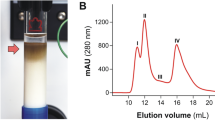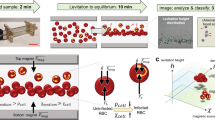Abstract
SEPARATION of the bloodstream forms of trypanosomes from the blood of infected animals has so far been difficult, especially in the case of Trypanosoma congolense. Even the most satisfactory method—defibrination of the blood followed by centrifugation on a sucrose gradient1—has the disadvantage of usually being applicable only to small volumes of blood, because of the high gradient volume to blood ratio (at least 6 to 1).
This is a preview of subscription content, access via your institution
Access options
Subscribe to this journal
Receive 51 print issues and online access
$199.00 per year
only $3.90 per issue
Buy this article
- Purchase on Springer Link
- Instant access to full article PDF
Prices may be subject to local taxes which are calculated during checkout
Similar content being viewed by others
References
Williamson, J., and Cover, B., Trans. Roy. Soc. Trop. Med. Hyg., 60, 425 (1966).
Desowitz, R. S., and Watson, H. J. C., Ann. Trop. Med. Parasit., 47, 62 (1953).
Lumsden, W. H. R., Cunningham, M. P., Webber, W. A. F., van Hoeve, K., and Walker, P. J., Exp. Parasitol., 14, 269 (1963).
Hollingshead, S., Pethica, B. A., and Ryley, J. F., Biochem. J., 89, 123 (1963).
Author information
Authors and Affiliations
Rights and permissions
About this article
Cite this article
LANHAM, S. Separation of Trypanosomes from the Blood of Infected Rats and Mice by Anion-exchangers. Nature 218, 1273–1274 (1968). https://doi.org/10.1038/2181273a0
Received:
Revised:
Issue Date:
DOI: https://doi.org/10.1038/2181273a0
This article is cited by
-
Sleeping sickness is a circadian disorder
Nature Communications (2018)
-
Genome-wide expression profiling of in vivo- derived bloodstream parasite stages and dynamic analysis of mRNA alterations during synchronous differentiation in Trypanosoma brucei
BMC Genomics (2009)
-
A surface transporter family conveys the trypanosome differentiation signal
Nature (2009)
-
A monoclonal antibody that inhibits Trypanosoma cruzi growth in vitro and its reaction with intracellular triosephosphate isomerase
Parasitology Research (2008)
-
Gene expression profiling in a mouse model for African trypanosomiasis
Genes & Immunity (2006)
Comments
By submitting a comment you agree to abide by our Terms and Community Guidelines. If you find something abusive or that does not comply with our terms or guidelines please flag it as inappropriate.



